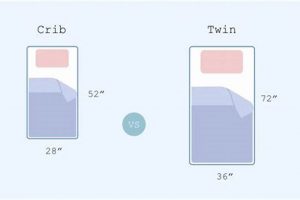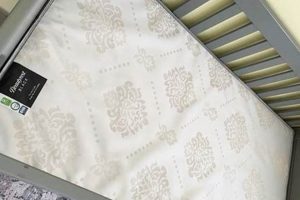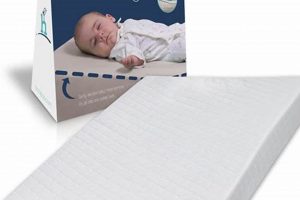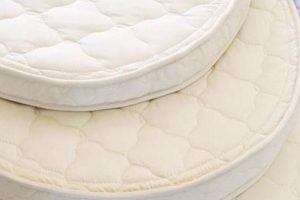The dimensions of infant sleeping surfaces designated for cribs are generally uniform. These regulated measurements ensure a safe and secure fit within the crib frame. For example, a common measurement for these mattresses is approximately 28 inches wide and 52 inches long, with a thickness that typically does not exceed 6 inches.
Adherence to these dimensional specifications is paramount for infant safety. A properly sized mattress minimizes the risk of gaps between the mattress and the crib frame, thereby reducing the potential for entrapment and suffocation. Historically, inconsistent sizing led to safety concerns, prompting the establishment of standardized measurements to mitigate such risks. This uniformity also simplifies the selection process for parents and caregivers.
Understanding these established dimensions is essential before purchasing bedding or other accessories for the crib. The following sections will delve into various aspects of crib mattress selection, including materials, firmness, and regulatory compliance, providing comprehensive guidance for ensuring a safe and comfortable sleep environment for infants.
Essential Considerations
The following guidance highlights crucial factors to consider when acquiring infant sleep surfaces, emphasizing safety and suitability.
Tip 1: Verify Dimensional Compliance: Prioritize mattresses that precisely conform to the established 28-inch by 52-inch dimensions. This ensures a snug fit within the crib frame, minimizing entrapment hazards.
Tip 2: Assess Firmness: Select a mattress with appropriate firmness. A firm surface is crucial for infant safety, as it reduces the risk of suffocation and promotes proper spinal development.
Tip 3: Scrutinize Material Composition: Examine the materials used in construction. Opt for non-toxic, hypoallergenic options that are free from harmful chemicals and allergens, safeguarding the infant’s health.
Tip 4: Evaluate Cover Quality: The mattress cover should be waterproof and easy to clean. This protects the mattress core from moisture and stains, maintaining hygiene and extending its lifespan.
Tip 5: Inspect Stitching and Seams: Thoroughly inspect the stitching and seams for durability and integrity. Weak or poorly constructed seams can lead to premature wear and potential safety hazards.
Tip 6: Consider Breathability: Look for mattresses with breathable designs. Adequate airflow helps regulate the infant’s body temperature and reduces the risk of overheating.
Tip 7: Confirm Certification: Seek mattresses certified by reputable safety organizations. Certifications ensure that the product has undergone rigorous testing and meets established safety standards.
These considerations are paramount for ensuring a safe and comfortable sleep environment for infants. Adherence to these guidelines contributes significantly to minimizing potential risks associated with infant sleep.
The subsequent sections will provide further information regarding regulatory standards and advanced features, offering a comprehensive understanding of infant sleep surface selection.
1. Width
The specification of a 28-inch width is a defining characteristic of the standard crib mattress. Deviation from this measurement introduces a risk of creating gaps between the mattress edge and the crib side rails. These gaps pose a potential entrapment hazard for infants, potentially leading to suffocation or injury. Therefore, the 28-inch width is not merely a dimension, but a critical safety parameter. The existence of a precise width standard is the result of historical incidents and safety studies that highlighted the dangers of non-compliant mattress sizes. For example, in cases where mattresses were narrower than 28 inches, infants have been known to roll into the resulting gap and become wedged, restricting breathing.
The implementation of the 28-inch width standard ensures that mattress manufacturers adhere to a uniform requirement, thus reducing the variability in crib mattress sizes available to consumers. This uniformity simplifies the mattress selection process, allowing caregivers to confidently choose a mattress certified as “standard” without needing to perform independent fit tests within their crib. The practical significance extends to accessory selection, such as fitted sheets, which are designed to accommodate this standardized width, ensuring a secure and wrinkle-free fit. Inconsistencies would lead to sheets that are either too loose, posing a strangulation risk, or too tight, potentially affecting mattress integrity.
In summary, the 28-inch width is an integral component of the standard crib mattress, directly influencing infant safety by minimizing entrapment risks. This dimension, stemming from safety concerns and practical considerations, fosters uniformity in mattress and accessory design, simplifying the selection process for caregivers. While challenges may arise in ensuring consistent enforcement of this standard across all manufacturers, the overarching goal remains minimizing potential hazards within the infant’s sleep environment, supported by industry self regulation and governmental intervention.
2. Length
The specification of a 52-inch length is a crucial element defining a standard crib mattress. This measurement, in conjunction with the standardized width, ensures compatibility with regulation cribs and directly impacts infant safety and comfort.
- Prevention of Longitudinal Gaps
The 52-inch length standard is primarily designed to prevent the formation of hazardous gaps along the length of the crib. Mattresses shorter than this dimension would create spaces where infants could become trapped, leading to potential suffocation or injury. This standardization prevents manufacturers from producing smaller mattresses to cut costs, thereby safeguarding infant well-being.
- Crib Compatibility
Regulatory agencies and crib manufacturers have established internal dimensions for standard-sized cribs. A mattress with a 52-inch length is engineered to fit snugly within these cribs, providing a secure and safe sleeping surface. Variations in this dimension would disrupt the intended design and compromise the crib’s safety features. The interaction between crib and mattress dimensions is crucial for regulatory compliance.
- Impact on Bedding Design
The 52-inch length also directly influences the design and manufacture of fitted sheets and other bedding accessories. These items are specifically tailored to fit mattresses of this length, ensuring a secure fit and preventing loose fabric that could pose a strangulation hazard. Deviations would render standardized bedding unusable and introduce potential risks.
- Historical Context and Safety Standards
The establishment of the 52-inch length is rooted in historical incidents involving non-compliant mattresses. These events prompted safety organizations to develop rigorous standards to minimize the risk of infant injury and death. Compliance with this length is mandatory for manufacturers seeking certification and market access, reflecting the paramount importance placed on infant safety.
In conclusion, the 52-inch length is an indispensable component of a standard crib mattress, primarily serving to prevent longitudinal gaps, ensure crib compatibility, and influence bedding design. The dimension’s historical context and strict adherence to safety standards underscore its vital role in providing a secure sleep environment for infants. Maintaining this standard is crucial for reducing the risks associated with infant sleep environments, demonstrating the significance of standardization in promoting product safety and protecting vulnerable populations.
3. Thickness
The regulation stipulating a maximum thickness of under 6 inches for infant crib mattresses is an integral component of the overall dimensional standards governing their manufacture and use. This specification is not arbitrary; it is directly linked to safety considerations regarding crib rail height and potential hazards associated with excessive mattress thickness.
- Crib Rail Height and Infant Safety
The height of crib side rails is engineered to prevent infants from climbing out of the crib. If a mattress exceeds the 6-inch thickness limit, it reduces the effective height of the side rails, increasing the risk of a child being able to climb over and fall. This is a direct safety implication. For instance, a crib designed with a 9-inch rail height will effectively have only 3 inches of rail remaining if a mattress of excessive thickness is used. Such a reduction significantly compromises the crib’s intended safety function, potentially leading to injuries.
- Minimizing Suffocation and Entrapment Risks
While firmness is the primary factor in minimizing suffocation risks, mattress thickness plays a secondary role. Excessively thick mattresses, particularly those with soft components, can create indentations that could pose a suffocation hazard if an infant rolls into a face-down position. Furthermore, thicker mattresses may contribute to entrapment risks if they do not fit snugly within the crib frame, creating spaces where an infant could become wedged. The 6-inch limit helps ensure a snug fit and reduces the likelihood of such hazardous scenarios.
- Regulatory Compliance and Testing Standards
Manufacturers must adhere to the thickness requirement to comply with safety regulations and certification standards. Testing protocols often include assessments of how mattress thickness affects crib rail height and overall stability. Non-compliance can result in product recalls and legal liabilities. For example, cribs and mattresses sold in regulated markets such as the United States must undergo rigorous testing to verify adherence to dimensional standards, including the 6-inch thickness limit, before being approved for sale.
- Impact on Mattress Materials and Construction
The thickness restriction also influences the types of materials and construction methods used in crib mattress manufacturing. Manufacturers must carefully select materials that provide adequate support and firmness while remaining within the prescribed thickness limit. This may involve utilizing higher-density foam or specialized innerspring systems. The focus is on achieving optimal comfort and safety within the dimensional constraints, necessitating careful consideration of material properties and manufacturing processes.
In conclusion, the “Thickness: Under 6 inches” specification is a vital element of standard crib mattress dimensions, intricately linked to crib rail height, suffocation risks, regulatory compliance, and mattress material selection. Adherence to this standard is paramount for ensuring infant safety and mitigating potential hazards associated with non-compliant crib mattresses. This regulation is a proactive measure rooted in historical incidents and ongoing safety research, designed to protect vulnerable infants within their sleep environment.
4. Rectangular shape
The rectangular shape is a fundamental and non-negotiable aspect of the established dimensions of infant crib mattresses. It is directly connected to the design and safety requirements of standard-sized cribs. Cribs are manufactured with a rectangular interior to provide a consistent and predictable space for the mattress. Any deviation from a rectangular shape in the mattress would compromise the intended fit, potentially creating gaps or uneven surfaces. These inconsistencies can pose significant safety hazards to infants.
The importance of the rectangular shape can be illustrated by considering alternative, non-standard shapes. A mattress with rounded corners, for example, would inevitably leave gaps at the corners of the crib. Similarly, a trapezoidal or irregularly shaped mattress would create extensive gaps along multiple sides. These gaps are not merely aesthetic concerns; they present a risk of infant entrapment, suffocation, and limb injury. The rectangular shape ensures that the mattress edges align as closely as possible with the crib’s interior, minimizing these risks. Moreover, the rectangular shape simplifies the manufacturing process and reduces costs. It allows for efficient cutting and assembly of mattress materials, resulting in a more standardized and affordable product.
The rectangular shape, therefore, is not merely a cosmetic feature but a critical component of the standard crib mattress size. It ensures compatibility with standard crib designs, minimizes safety hazards, and promotes manufacturing efficiency. Deviation from this shape would undermine the safety and functionality of the crib-mattress system, highlighting the practical significance of understanding and adhering to this essential dimensional characteristic. Challenges to this include illegal manufacture of mattresses.
5. Firmness crucial
The designation “Firmness crucial” within the context of infant crib mattresses highlights a paramount safety consideration directly linked to the established size standards. Appropriate firmness is not merely a comfort preference; it is a fundamental requirement for mitigating critical risks associated with infant sleep.
- Suffocation Prevention
The primary role of a firm crib mattress is to minimize the risk of suffocation. Infants lack the motor skills necessary to reposition themselves if their faces become pressed against a yielding surface. A soft mattress can conform to the infant’s face, obstructing airways and leading to potentially fatal outcomes. Data from safety organizations consistently demonstrate a correlation between softer sleep surfaces and increased suffocation risk. For instance, studies have shown that infants placed on overly soft mattresses have a significantly higher incidence of Sudden Infant Death Syndrome (SIDS) and accidental suffocation compared to those on firmer surfaces. Therefore, adhering to firmness standards is non-negotiable for ensuring infant safety.
- Spinal Development Support
A firm mattress provides essential support for the infant’s developing spine. The musculoskeletal system of a newborn requires a stable and unyielding surface to promote proper alignment and growth. A soft mattress can lead to spinal misalignment and potential developmental issues. Medical professionals recommend a firm sleeping surface to maintain the natural curvature of the spine and prevent postural abnormalities. In contrast, a yielding mattress can cause the infant’s spine to sink or curve unnaturally, potentially leading to long-term orthopedic problems. The American Academy of Pediatrics advises parents and caregivers to prioritize firmness to support healthy spinal development.
- Minimizing Entrapment Hazards
While the dimensions of the crib mattress minimize gaps around the perimeter, a firm surface further reduces the risk of entrapment. A soft mattress can compress or deform, creating small pockets or indentations where an infant could become wedged. If an infant rolls against the side of the crib, a firm mattress will maintain its shape, preventing the formation of hazardous spaces. This characteristic is especially important in older cribs or those with slightly larger gaps between the mattress and frame. A firm surface provides an additional layer of safety, mitigating the potential for entrapment-related injuries.
- Regulatory Compliance and Testing
The firmness of crib mattresses is a key factor in regulatory compliance and safety testing protocols. Government agencies and independent certification organizations establish minimum firmness standards to ensure that all crib mattresses meet specific safety criteria. Mattresses undergo rigorous testing to evaluate their firmness characteristics, including indentation load deflection (ILD) measurements and surface compression tests. Products that fail to meet these standards cannot be certified or legally sold as infant crib mattresses. This rigorous testing process ensures that mattresses marketed as “firm” provide an adequate level of support and minimize associated safety risks. For example, the Consumer Product Safety Commission (CPSC) enforces firmness standards to reduce the likelihood of sleep-related injuries and fatalities.
In conclusion, “Firmness crucial” is an indispensable element within the context of the standard crib mattress size. This characteristic directly addresses critical safety concerns, including suffocation prevention, spinal development support, and minimization of entrapment hazards. Regulatory compliance and rigorous testing reinforce the importance of firmness as a fundamental requirement for all infant crib mattresses. By prioritizing mattress firmness, caregivers significantly reduce the risk of sleep-related injuries and promote a safer sleep environment for infants.
6. Gap minimization
Gap minimization is an intrinsic objective in the design and regulation of infant cribs and mattresses. Adherence to dimensional specifications is essential to reduce potential hazards associated with excessive space between the mattress and the crib frame.
- Dimensional Compliance
The standardization of crib mattress sizes, specifically the 28-inch by 52-inch dimension, aims to ensure a snug fit within regulation-sized cribs. Accurate dimensions are critical to minimize gaps that can lead to infant entrapment. Examples include instances where non-compliant mattresses, either too small or misshapen, have created spaces where infants became wedged, resulting in injury or suffocation. A precise fit, dictated by strict adherence to dimensional standards, is paramount for safety.
- Crib Design Standards
Crib manufacturers must adhere to established design criteria, including consistent interior dimensions, to accommodate standard-sized mattresses. Regulatory standards mandate that cribs maintain specific interior measurements to facilitate gap minimization. For example, the distance between crib slats is also regulated to prevent limb entrapment, further complementing the role of a properly sized mattress in minimizing potential hazards. Deviation from these crib design standards can negate the benefits of a correctly sized mattress.
- Importance of Fitted Sheets
Fitted sheets designed for standard crib mattresses contribute to gap minimization by providing a snug and secure covering. Loose or improperly sized sheets can bunch up, creating potential suffocation hazards or obscuring gaps that may exist between the mattress and the crib frame. The proper use of appropriately sized fitted sheets complements the role of mattress dimensions in maintaining a safe sleep environment.
- Continuous Monitoring and Revision of Standards
Regulatory bodies and safety organizations continually monitor incidents related to crib and mattress safety to identify potential areas for improvement in standards. Gap minimization remains a central focus of these ongoing evaluations. Examples include revisions to crib slat spacing requirements and enhancements to mattress flammability standards, reflecting the dynamic nature of safety regulations in response to emerging risks and incident data. Continuous monitoring ensures that standards remain relevant and effective in protecting infants.
These facets collectively underscore the importance of gap minimization as an integral element of standard crib mattress design and regulatory oversight. Adherence to dimensional standards, consistent crib design, appropriate bedding selection, and continuous monitoring contribute to a safer sleep environment for infants, highlighting the multi-faceted approach required to effectively minimize potential hazards.
Frequently Asked Questions
The following questions address common concerns regarding crib mattress dimensions and their implications for infant safety.
Question 1: What constitutes the officially recognized dimensions for a standard crib mattress?
The standardized dimensions are 28 inches in width and 52 inches in length. Thickness should not exceed 6 inches. Adherence to these measurements is critical for ensuring a safe fit within standard-sized cribs.
Question 2: Why is adherence to the stated dimensions so crucial?
Precise dimensions minimize gaps between the mattress and the crib frame. These gaps pose a significant risk of infant entrapment, potentially leading to suffocation or serious injury. Consistent dimensions mitigate this hazard.
Question 3: What are the potential consequences of using a mattress that deviates from the standard size?
A mattress that is too small can create hazardous gaps. Conversely, a mattress that is too large may not fit properly, potentially leading to structural instability or uneven sleeping surfaces, compromising infant safety.
Question 4: How does mattress firmness relate to the overall safety of a standard crib mattress?
Firmness is a critical factor independent of mattress dimensions. A firm surface reduces the risk of suffocation by preventing the mattress from conforming to the infant’s face and obstructing airways. A soft mattress is dangerous, regardless of its size.
Question 5: Where can one find reliable information regarding crib mattress safety standards and certifications?
Information may be obtained from regulatory bodies such as the Consumer Product Safety Commission (CPSC) and certification organizations. These entities provide guidelines and certifications that ensure compliance with established safety protocols.
Question 6: What actions should be taken if a potential safety issue is identified with a crib mattress?
If any safety concerns arise, the mattress should be immediately removed from use. Contact the manufacturer or retailer to report the issue. Additionally, consider reporting the incident to the CPSC to contribute to ongoing safety monitoring efforts.
The information presented herein emphasizes the importance of adhering to established safety standards for infant crib mattresses. Prioritizing safety is paramount when selecting products intended for infant use.
The following section will address additional considerations for maintaining a safe sleep environment for infants.
Conclusion
The preceding exploration of “standard crib mattress size” underscores its vital role in ensuring infant safety. Adherence to the specified dimensions28 inches in width, 52 inches in length, and a thickness not exceeding 6 inchesis paramount for minimizing the risk of entrapment and suffocation. The rectangular shape, coupled with appropriate firmness, further contributes to a secure sleep environment.
The ongoing commitment to standardization and regulatory oversight remains essential for protecting vulnerable infants. Diligence in selecting crib mattresses that meet established safety criteria, combined with vigilant monitoring and prompt reporting of potential hazards, is crucial. The health and well-being of infants depend on the consistent application and enforcement of these safety measures.



![Best Compact Crib Mattress Size Guide: [Year] Organic & Natural Mattress Buyer’s Guide: Non-Toxic Sleep Solutions Best Compact Crib Mattress Size Guide: [Year] | Organic & Natural Mattress Buyer’s Guide: Non-Toxic Sleep Solutions](https://mattressworldpa.com/wp-content/uploads/2025/07/th-1300-300x200.jpg)



